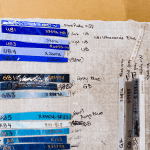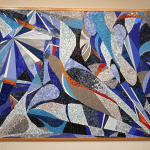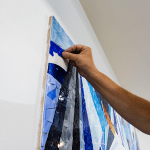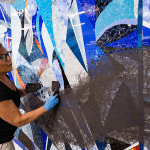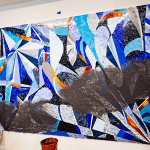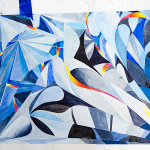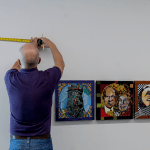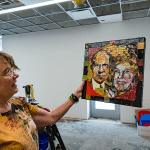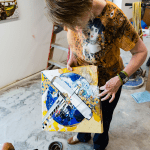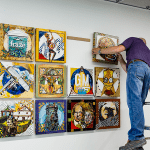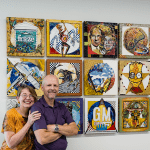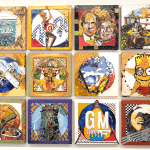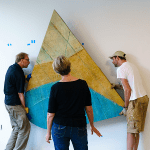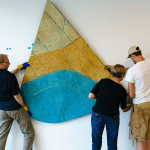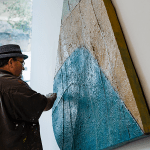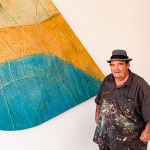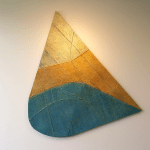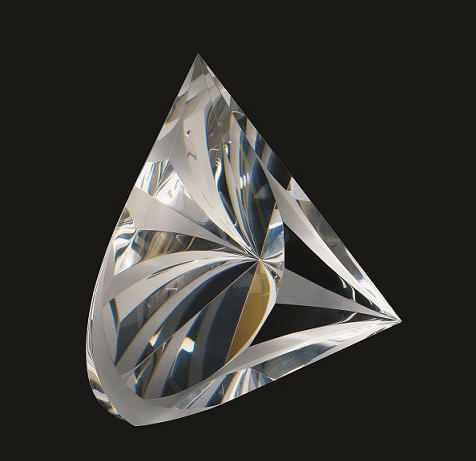Kettering-Moraine
About the Kettering-Moraine Art Installation and Artists
Gail Christofferson (b.1960) American, FACETED EDGE, 2016, Glass mosaic, Collection of the Dayton Metro Library, 2016.8
Bowling Green, Ohio based mosaic artist, Gail Christofferson worked with illustrator Debra Buchanan to create Faceted Edge, inspired by Celebration, a work by Christopher Ries from the collection of The Dayton Art Institute. Composed of naturally reflective, individual pieces of colored glass a mosaic mural is a diverse but unified whole, suggestive of the community of individuals who live, work and in this case, visit the library.
About the Artist
GAIL CHRISTOFFERSON and DEBRA BUCHANAN | Gail Christofferson is a mosaic artist from Bowling Green Ohio. Known for her large–scale mosaic murals, Christofferon’s work is often community based, offering a sense of ownership and pride as each individuals’ contributions combine with others to form a finished piece that is both aesthetically and socially engaging.
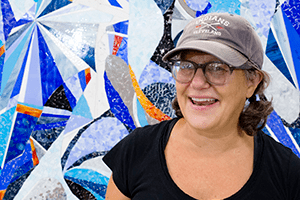
Visit www.animalhouseglass.com for more information about this artist. Debra Buchanan is an illustrator from Toledo, Ohio whose works have been included in numerous exhibitions nationally and regionally. She is represented by the Toledo Museum of Art's Collectors Corner. Her website is www.debra-buchanan.squarespace.com.
Marsha Monroe Pippenger (b.1957) American, LUMINARIES, 2016, Papier collé, Collection of the Dayton Metro Library, 2016.10
Inspired by the design and symbolism of the Japanese Trunk with Family Crests Design from the collection of The Dayton Art Institute, Pippenger created 12 individual collages representing people, places and events special to the Kettering- Moraine community. Chosen by the people of Kettering-Moraine the works depict Charles and Virginia Kettering, the Wisconsin glacier, the Fraze Pavilion, Hills and Dales Park, Holiday at Home, Bart Simpson, the Fairmont Firebird, Ermal Fraze, inventor of the Pop Top can, Dayton Wright Airplane Factory, Polen Farm, Delco Light, General Motors, and Frigidaire; and Moraine farm.
About the Artist
MARSHA PIPPENGER | Dayton artist Marsha Monroe Pippenger works in papier collé, or paper collage. This medium is well suited to Pippenger’s style of visual expression which combines elements of painting, drawing, sculpture and assemblage. In a process of building and layering, of adding and taking away, Pippenger employs brilliant color, creates texture, builds values and adds dimension to complete a carefully unified whole. For more information about this artist please visit: www.pippengerart.com.
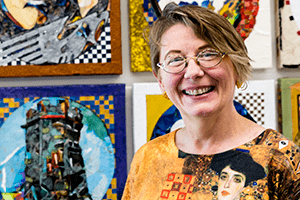
Mike Elsass (b.1947) American, UNEXPECTED OUTCOMES FROM IMPROBABLE PAIRINGS, 2016, Acrylic, oil, mica, pumice, glass-beads and tar on shaped, weathered steel,
Elsass’ work was inspired by Christopher Ries’ work Celebration from the collection of The Dayton Art Institute. Elsass references the shape of Celebration in his three-piece work painted in layers of soft, airy, iridescent colors with varying textures.
About the Artist
MIKE ELSASS | Dayton based artist Mike Elsass paints on weathered steel in an abstract style inspired by the color field artists. Applying multiple layers of paint and other organic material, Elsass paints, sponges, and sands, often building as many as 40 layers on these steel sheets until the final glazing. Mindful of the moment when paint, color, texture and discovery meet, Elsass considers his art spiritual and meditative. For more information about this artist please visit: www.mikeelsass.com.
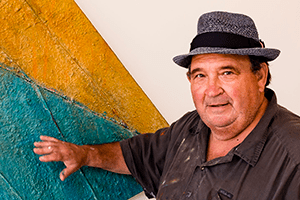
The Stories Behind the Kettering-Moraine Art Inspiration
From the Collection of the Dayton Art Institute
Christopher Ries (b. 1952) American, Celebration, 1998, Cut and polished optical glass, 17 x 22 x 7 inches, The Dayton Art Institute, Museum purchase with funds provided by the James F. Dicke Family, 1999.31
From afar, this cut glass form appears as a mere sliver of glass, but from other angles its exterior resembles the shape of a cornucopia. As one circles the object, the multiple facets cut into the surface refract light and create bending, pulsing patterns. Ries works within a factory setting, utilizing large blocks of optic crystal to create works of profound simplicity yet with masterful skill.
View this artwork and learn more by clicking here, opens a new window or visit The Dayton Art Institute.
Japanese, Edo period (1615-1868) Trunk with Family Crests Design, 18th century, Lacquer on wood with gilt, pigments and metal fittings, 31 ½ x 60 x 26 inches, The Dayton Art Institute, Gift of Mrs. Julia Davidson Cheshire, Mrs. Frances Davidson Bortz, Mrs. Mary Davidson Swift, and Mr. Stuart C. Davidson, 1961.89
This large lacquered chest is a unique work of art, but not for the reasons you might think. Research shows that the arrangement of the seals, or mon, don’t match up with history. While mon were put on various items owned by those in the samurai class, the representation of so many mon on this chest indicate that it was probably made for export for foreigners unfamiliar with samurai culture in Edo period Japan.
How did these pieces inspired our artists?
“Our design incorporates the dynamic, angular forms of Ries’ work, expressing the energy and implied motion on an essentially flat surface. Rendering the design as a glass mosaic allows additional exploration of the refraction of light and the resulting combinations of colors.” Gail Christofferson, artist
“I was inspired by the unique shape and multi-faceted surface of Ries’ Celebration which motivated me to create a work of separate sections, each with their own unique identity, but fitting together as a whole.” Mike Elsass, artist
“Luminaries reflects the design and pattern of the mons on the Japanese chest as well as their symbolic nature to showcase the history, people and accomplishments of the community. The luminaries were chosen by the people of Kettering and Moraine to honor them and to link past histories to the present and future.” Marsha Monroe Pippenger, artist
Thank you to our partner,
the Dayton Art Institute, opens a new window.
Photos of ReImagining Works pieces taken by Andy Snow.

